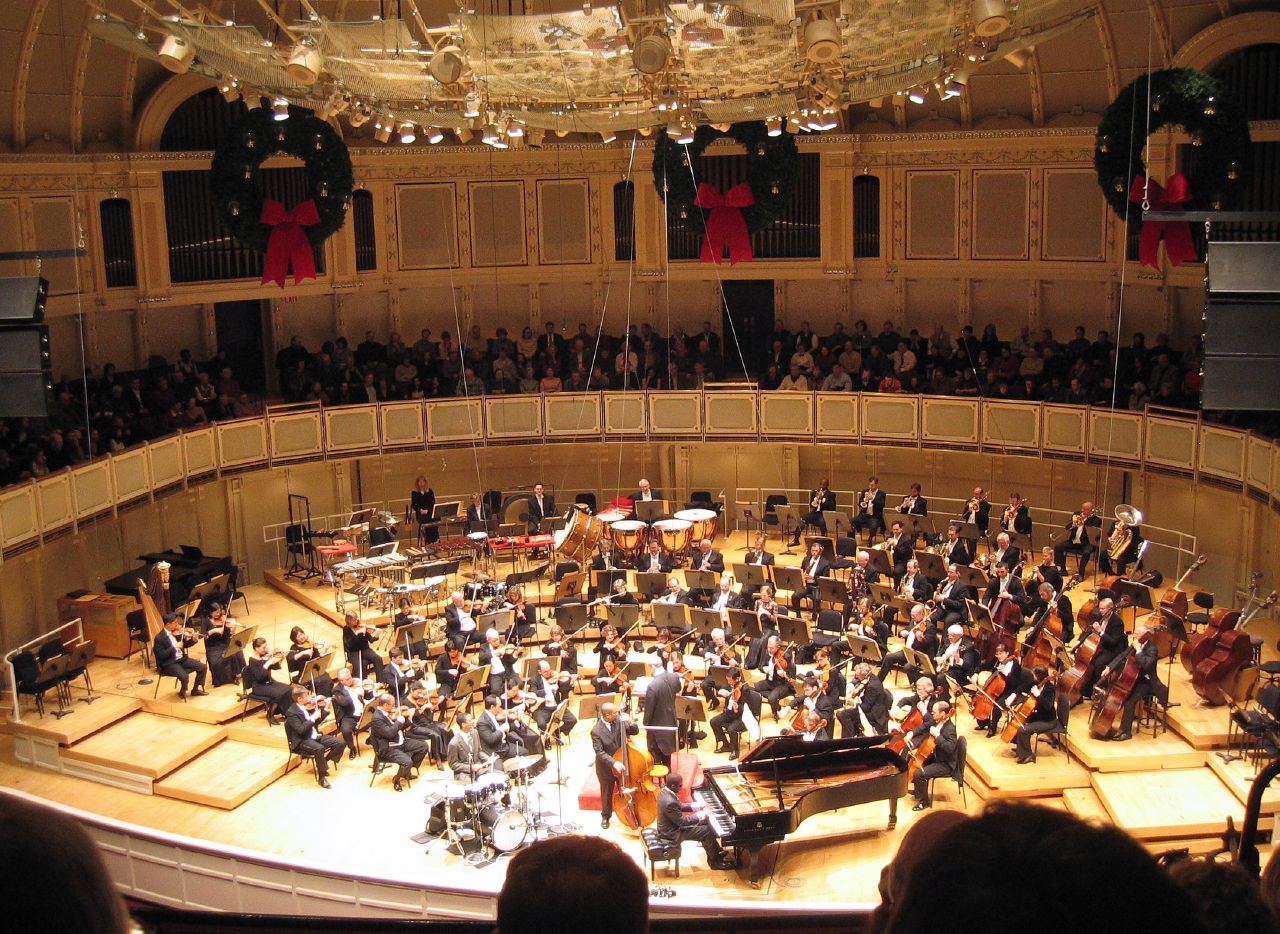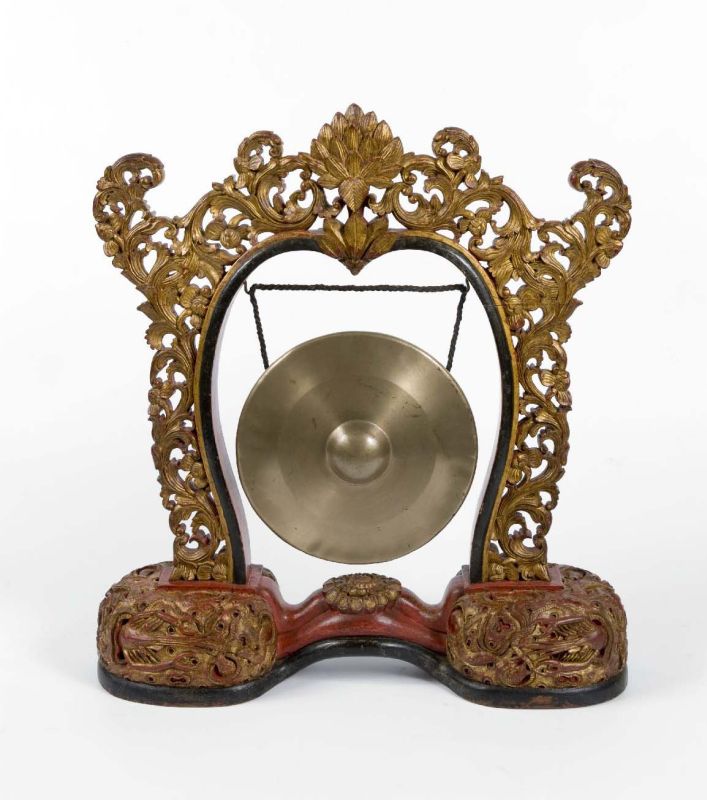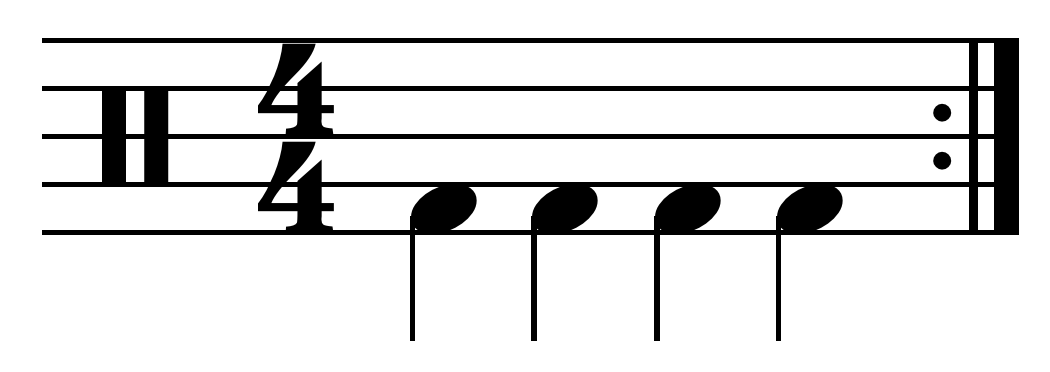|
Symphony No. 5 (Shostakovich)
The Symphony No. 5 in D minor, Op. 47, by Dmitri Shostakovich is a work for orchestra composed between April and July 1937. Its first performance was on November 21, 1937, in Leningrad by the Leningrad Philharmonic Orchestra under Yevgeny Mravinsky. The premiere was a "triumphal success" that appealed to both the public and official critics, receiving an ovation that lasted well over half an hour. Instrumentation The work is scored for two flutes and piccolo, two oboes, two clarinets and E clarinet, two bassoons and contrabassoon, four horns, three B trumpets, three trombones, tuba, timpani, snare drum, triangle, cymbals, bass drum, tam-tam, glockenspiel, xylophone, two harps (one part), piano, celesta and strings. Form First movement: Moderato \new staff \relative c The first movement, in D minor, is in sonata form. The exposition opens with a "strenuous" string figure in canon of rising and falling minor sixths that quickly narrow to minor thirds. The opening's d ... [...More Info...] [...Related Items...] OR: [Wikipedia] [Google] [Baidu] |
Opus Number
In music, the opus number is the "work number" that is assigned to a musical composition, or to a set of compositions, to indicate the chronological order of the composer's publication of that work. Opus numbers are used to distinguish among compositions with similar titles; the word is abbreviated as "Op." for a single work, or "Opp." when referring to more than one work. Opus numbers do not necessarily indicate chronological order of composition. For example, posthumous publications of a composer's juvenilia are often numbered after other works, even though they may be some of the composer's first completed works. To indicate the specific place of a given work within a music catalogue, the opus number is paired with a cardinal number; for example, Beethoven's Piano Sonata No. 14 in C-sharp minor (1801, nicknamed ''Moonlight Sonata'') is "Opus 27, No. 2", whose work-number identifies it as a companion piece to "Opus 27, No. 1" ( Piano Sonata No. 13 in E-flat major, 1800 ... [...More Info...] [...Related Items...] OR: [Wikipedia] [Google] [Baidu] |
Timpani
Timpani (; ) or kettledrums (also informally called timps) are musical instruments in the percussion instrument, percussion family. A type of drum categorised as a hemispherical drum, they consist of a Membranophone, membrane called a drumhead, head stretched over a large bowl traditionally made of copper. Thus timpani are an example of kettledrums, also known as vessel drums and semispherical drums, whose body is similar to a section of a sphere whose cut conforms the head. Most modern timpani are ''pedal timpani'' and can be tuned quickly and accurately to specific pitches by skilled players through the use of a movable foot-pedal. They are played by striking the head with a specialized Beater (percussion), beater called a ''timpani stick'' or ''timpani mallet''. Timpani evolved from military drums to become a staple of the European classical music, classical orchestra by the last third of the 18th century. Today, they are used in many types of Musical ensemble, ensembles, incl ... [...More Info...] [...Related Items...] OR: [Wikipedia] [Google] [Baidu] |
Canon (music)
In music, a canon is a contrapuntal (counterpoint-based) compositional technique that employs a melody with one or more imitation (music), imitations of the melody played after a given duration (music), duration (e.g., quarter rest, one measure, etc.). The initial melody is called the leader (or ''dux''), while the imitative melody, which is played in a different part (music), voice, is called the follower (or ''comes''). The follower must imitate the leader, either as an exact replication of its rhythms and Interval (music), intervals or some transformation thereof. Repeating canons in which all voices are musically identical are called round (music), rounds—familiar singalong versions of "Row, Row, Row Your Boat" and "Frère Jacques" that call for each successive group of voices to begin the same song a bar or two after the previous group began are popular examples. An accompanied canon is a canon accompanied by one or more additional independent parts that do not imitate th ... [...More Info...] [...Related Items...] OR: [Wikipedia] [Google] [Baidu] |
Sonata Form
The sonata form (also sonata-allegro form or first movement form) is a musical form, musical structure generally consisting of three main sections: an exposition, a development, and a recapitulation. It has been used widely since the middle of the 18th century (the early Classical music era, Classical period). While it is typically used in the first Movement (music), movement of multi-movement pieces, it is sometimes used in subsequent movements as well—particularly the final movement. The teaching of sonata form in music theory rests on a standard definition and a series of hypotheses about the underlying reasons for the durability and variety of the form—a definition that arose in the second quarter of the 19th century. There is little disagreement that on the largest level, the form consists of three main sections: an exposition, a development, and a recapitulation; however, beneath this general structure, sonata form is difficult to pin down to a single model. The standa ... [...More Info...] [...Related Items...] OR: [Wikipedia] [Google] [Baidu] |
String Section
The string section of an orchestra is composed of bowed instruments belonging to the violin family. It normally consists of first and second violins, violas, cellos, and double basses. It is the most numerous group in the standard orchestra. In discussions of the Orchestration, instrumentation of a musical work, the phrase "the strings" or "and strings" is used to indicate a string section as just defined. An orchestra consisting solely of a string section is called a string orchestra. Smaller string sections are sometimes used in jazz, pop, and rock music and in the pit orchestras of musical theatre. Seating arrangement The most common seating arrangement in the 2000s is with first violins, second violins, violas, and cello sections arrayed clockwise around the Conductor (music), conductor, with basses behind the cellos on the right. The first violins are led by the concertmaster (leader in the UK); each of the other string sections also has a principal player (principal secon ... [...More Info...] [...Related Items...] OR: [Wikipedia] [Google] [Baidu] |
Celesta
The celesta () or celeste (), also called a bell-piano, is a struck idiophone operated by a keyboard. It looks similar to an upright piano (four- or five-octave), albeit with smaller keys and a much smaller cabinet, or a large wooden music box (three-octave). The keys connect to hammers that strike a graduated set of metal (usually steel) plates or bars suspended over wooden resonators. Four- or five-octave models usually have a damper pedal that sustains or damps the sound. The three-octave instruments do not have a pedal because of their small "table-top" design. One of the best-known works that uses the celesta is Pyotr Ilyich Tchaikovskys "Dance of the Sugar Plum Fairy" from ''The Nutcracker''. The sound of the celesta is similar to that of the glockenspiel, but with a much softer and more subtle timbre. This quality gave the instrument its name, ''celeste'', meaning "heavenly" in French. The celesta is often used to enhance a melody line played by another instrument or ... [...More Info...] [...Related Items...] OR: [Wikipedia] [Google] [Baidu] |
Piano
A piano is a keyboard instrument that produces sound when its keys are depressed, activating an Action (music), action mechanism where hammers strike String (music), strings. Modern pianos have a row of 88 black and white keys, tuned to a chromatic scale in equal temperament. A musician who specializes in piano is called a pianist. There are two main types of piano: the #Grand, grand piano and the #Upupright piano. The grand piano offers better sound and more precise key control, making it the preferred choice when space and budget allow. The grand piano is also considered a necessity in venues hosting skilled pianists. The upright piano is more commonly used because of its smaller size and lower cost. When a key is depressed, the strings inside are struck by felt-coated wooden hammers. The vibrations are transmitted through a Bridge (instrument), bridge to a Soundboard (music), soundboard that amplifies the sound by Coupling (physics), coupling the Sound, acoustic energy t ... [...More Info...] [...Related Items...] OR: [Wikipedia] [Google] [Baidu] |
Harp
The harp is a stringed musical instrument that has individual strings running at an angle to its soundboard; the strings are plucked with the fingers. Harps can be made and played in various ways, standing or sitting, and in orchestras or concerts. Its most common form is triangular in shape and made of wood. Some have multiple rows of strings and pedal attachments. Ancient depictions of harps were recorded in Mesopotamia (now Iraq), Persia (now Iran) and Egypt, and later in India and China. By medieval times harps had spread across Europe. Harps were found across the Americas where it was a popular folk tradition in some areas. Distinct designs also emerged from the African continent. Harps have symbolic political traditions and are often used in logos, including in Ireland. Historically, strings were made of sinew (animal tendons). Other materials have included gut (animal intestines), plant fiber, braided hemp, cotton cord, silk, nylon, and wire. In pedal harp scor ... [...More Info...] [...Related Items...] OR: [Wikipedia] [Google] [Baidu] |
Xylophone
The xylophone (; ) is a musical instrument in the percussion family that consists of wooden bars struck by mallets. Each bar is an idiophone tuned to a pitch of a musical scale, whether pentatonic or heptatonic in the case of many African and Asian instruments, diatonic in many western children's instruments, or chromatic for orchestral use. The term ''xylophone'' may be used generally, to include all such instruments such as the marimba, balafon and even the semantron. However, in the orchestra, the term ''xylophone'' refers specifically to a chromatic instrument of somewhat higher pitch range and drier timbre than the marimba, and these two instruments should not be confused. A person who plays the xylophone is known as a ''xylophonist'' or simply a ''xylophone player''. The term is also popularly used to refer to similar instruments of the lithophone and metallophone types. For example, the Pixiphone and many similar toys described by the makers as xylophones have b ... [...More Info...] [...Related Items...] OR: [Wikipedia] [Google] [Baidu] |
Glockenspiel
The glockenspiel ( ; or , : bells and : play) or bells is a percussion instrument consisting of pitched aluminum or steel bars arranged in a Musical keyboard, keyboard layout. This makes the glockenspiel a type of metallophone, similar to the vibraphone. The glockenspiel is played by striking the bars with Percussion mallet, mallets, often made of a hard material such as metal or plastic. Its clear, high-pitched tone is often heard in Orchestra, orchestras, Concert band, wind ensembles, Marching band, marching bands, and in popular music. Terminology In German, a carillon is also called a , and in French, the glockenspiel is sometimes called a . It may also be called a () in French, although this term may sometimes be specifically reserved for the keyboard glockenspiel. In Italian, the term () is used. The glockenspiel is sometimes erroneously referred to as a xylophone. (The xylophone has wooden bars, unlike the glockenspiel which has metal bars.) The Pixiphone, a type of ... [...More Info...] [...Related Items...] OR: [Wikipedia] [Google] [Baidu] |
Gong
A gongFrom Indonesian language, Indonesian and ; ; zh, c=鑼, p=luó; ; ; ; ; is a percussion instrument originating from Southeast Asia, and used widely in Southeast Asian and East Asian musical traditions. Gongs are made of metal and are circular and flat or bowl-like in shape, and can come in various sizes. They are typically struck with a mallet. They can be played alone, giving a characteristic "crashing" sound, or played as part of a tuned set that produce bell-like sounds. The earliest possible depictions of gongs is from the details on the surface of the Ngọc Lũ I Dong son drum, bronze drum () from the Dong Son culture of northern Vietnam. It depicts what looks like seven-gong ensembles along with other instruments (including cymbals/bells and the bronze drums themselves). The oldest undisputed historical mention of gongs can be found in sixth century AD Chinese records, which mentioned it as a foreign instrument that came from a country between Tibet and Bur ... [...More Info...] [...Related Items...] OR: [Wikipedia] [Google] [Baidu] |
Bass Drum
The bass drum is a large drum that produces a note of low definite or indefinite pitch. The instrument is typically cylindrical, with the drum's diameter usually greater than its depth, with a struck head at both ends of the cylinder. The heads may be made of calfskin or plastic and there is normally a means of adjusting the tension, either by threaded taps or by strings. Bass drums are built in a variety of sizes, but size does not dictate the volume produced by the drum. The pitch and the sound can vary much with different sizes,Norman Del Mar, Del Mar, Norman (1981). ''Anatomy of the Orchestra''. . but the size is also chosen based on convenience and aesthetics. Bass drums are percussion instruments that vary in size and are used in several musical genres. Three major types of bass drums can be distinguished. * The type usually seen or heard in orchestral, ensemble or concert band music is the orchestral, or concert bass drum (in Italian: gran cassa, gran tamburo). It is the ... [...More Info...] [...Related Items...] OR: [Wikipedia] [Google] [Baidu] |








